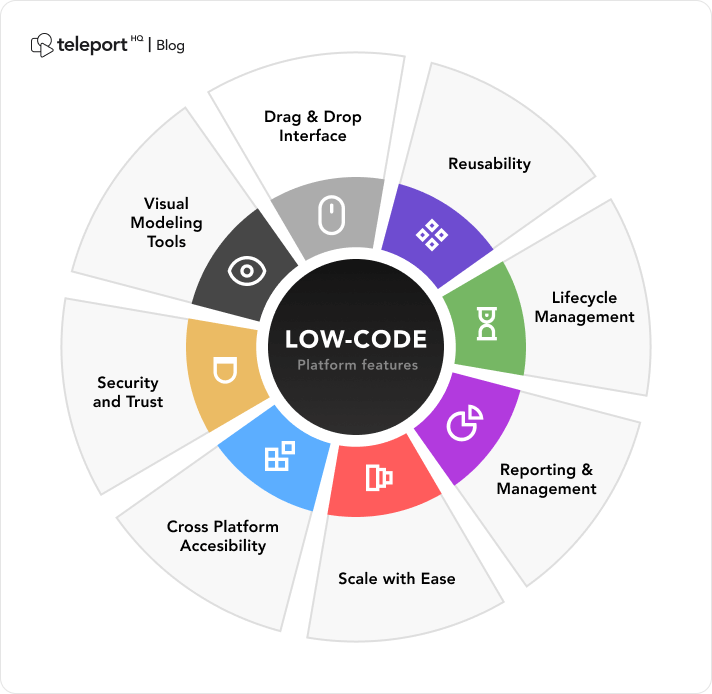Best Ideas On Deciding On Legacy application modernization with Low-code
Best Ideas On Deciding On Legacy application modernization with Low-code
Blog Article
Benefits Of Low-Code Application Development In Terms Of Accessibility To Non-Developers
Low-code app development improves accessibility for non-developers (often referred to "citizen-developers") because of several key elements.
Drag-and -Drop Builders. Low-code platforms come with drag-and -drop interfaces. This provides non-programmers with the ability to create applications in a visual manner, without writing code. This makes it much easier for those with less technical background to participate in the process of development.
WYSIWYG editors The WYSIWYG editors "What You See Is What You Get" editors allow users to build workflows and interfaces that are like the final product. This makes it simpler to understand and use.
Simple Logic and Workflow:
Visual Workflow Modeling: Users are able to develop business processes, application logic and flowcharts through models and visual flowcharts. These techniques are more intuitive than traditional coding methods.
Pre-built Logic Components: Low-code platforms include logic components that have been pre-built (e.g. conditional loops and statements), which can be configured easily which eliminates the need for complicated coding.
Templates and components that are reuseable:
Library of Templates pre-built: A lot of platforms that allow low-code also have a library of template types for the most common applications. This lets developers start quickly and efficiently while non-developers are able to customize the templates as they see the need.
Reusable Modules and Widgets: With the help of the reuse of modules and widgets users can speed up the creation process and reduce the requirement for technical knowledge.
Guided Development and Tutorials
Step-byStep Guides: Platforms will frequently provide guided development pathways, online tutorials, or screen-based instructions that can assist those who are not developers in developing applications.
Interactive Tutorials Interactive tutorials are interactive and hands-on, which help users to learn through doing. This improves the confidence of users in the platform.
Integration with Existing Tools
Seamless Integration: Low-code platforms are designed to seamlessly integrate with existing tools and systems in business (e.g. the CRM or ERP) that permits non-developers to build applications that work with current workflows.
APIs Connectors: APIs are built into applications to simplify integration. This allows non-programmers with no programming skills, to connect with external services.
Collaboration Features:
Team Collaboration: Features like real-time collaborative workspaces and shared workspaces make it feasible for non-developers to effectively collaborate with developers, business analyst, and other stakeholders.
Access Control based on Role: Users who are not developers can be assigned roles with the appropriate access levels. This allows them to participate in the development process without compromising security and functionality.
Automated Testing, Debugging and Debugging
Low-code platforms are often equipped with debugging and testing software that can automatize these processes. This makes it simpler for non-developers to check their applications function correctly.
Error Highlighting - If issues occur, the system highlights the issue and offers solutions, while guiding users through troubleshooting.
Overall, the main advantage of developing low-code applications for non-developers is in its ability to democratize the process of development. Through providing intuitive, visually-guided tools and experiences, low-code platforms enable business owners to actively take part in and manage applications. Follow the most popular Low-code Platform for application development info for more tips including application modernization, low code platforms, develop web app, lowcode no code, low code development platforms, develop cross platform mobile app, lowcode no code, ms azure sql, azure sql server, develop cross platform mobile app and more.
Cost-Effectiveness Is Just One Of The Many Advantages Of Developing Apps With Low-Code.
Low-code development has many benefits in terms of cost-effectiveness. This is a great option for companies looking to maximize their development budgets, but still providing top quality software. The following are some key advantages.
Less Coding Requirements: The low code platforms eliminate the need for lengthy hand-coded apps. Developers will save time and energy building applications. This results in less labor costs.
We need fewer resources for developers: Programming with low-code is faster and easier, so less developers with specialization are needed. Hiring and staffing costs can be reduced significantly.
Speedier time to market
Development speed up: Visual development tools as well as pre-built components provided by platforms that use low-code allow rapid design of applications, which allows companies to deliver products to market more quickly. This could result in faster revenues and better competitive positioning.
Rapid Prototyping. Businesses can test quickly and build prototypes. This reduces time spent in the development process and enables rapid iterations built on feedback from users.
Low Maintenance Costs
Simpler Maintenance: Low-code platforms, with their modular components and standardised components make them easier to maintain. This can reduce the expense of ongoing maintenance and support.
Automated Updates: Many low-code platforms can handle updates and patches automatically, ensuring applications remain secure and up-to-date without requiring lengthy manual intervention.
Efficient Resource Utilization:
Contributions by non-developers Low-code platforms enable non-developers and users from the business sector to participate in the process of development. This lets employees and businesses collaborate, thereby reducing the dependence on highly paid developers.
Improved utilization of IT resources IT departments are given the chance to concentrate on more strategic projects instead of being bogged-down with routine work tasks for development. Overall productivity and efficiency improves.
Scalable Pricing Models
Subscription-Based Pricing: A lot of low-code platforms provide flexible subscription-based pricing that scales with usage. This lets companies adjust their budgets according to their growth and requirements without the need to incur large initial cost.
Pay-Assosiated Option: A few platforms provide pay-assosiated choices. These options ensure that companies pay only for the resources used and are beneficial for small and new businesses with limited funds.
Costs of Third-Party Software reduced:
Low-code platforms have built-in integrations and functionalities, which can lower the cost of software subscriptions and licensing.
Integrations pre-built: These systems and services can be integrated with other popular services, which eliminates the need for custom-built software and saves both time and cost.
Increased ROI
Faster Return On Investment: Rapid development and lower costs with a faster time to marketing allows businesses to get a greater return on investment.
Increased agility: Businesses are able to respond quickly to changes in the market or customer demands which enables businesses to stay relevant and benefit from new opportunities.
Low-cost Training:
User-Friendly Interfaces: Low-code platforms are user-friendly and have simple interfaces, which reduces the time required to learn.
Accessible Resources Low-Code Platforms: Many low-code platforms have complete training materials, tutorials, and support for community members, thereby cutting the need for formal training and associated expenses.
Collaboration streamlined:
Improved Collaboration Tools Collaboration tools are integrated into the workflow. This enables improved communication between team members as well as an improvement in overhead for projects.
Unified Development Environment. An unified development platform helps reduce costs and streamline workflows through simplifying the management of several tools.
In general, applications that use low-code cost less due to their ability to reduce costs for maintenance and development, to accelerate time-to-market, to maximize resource use, and to provide flexibility in pricing. These factors combine to deliver substantial financial benefits to businesses, making low-code a compelling choice for businesses looking to increase their budgets for development while also delivering solid, scalable and top-quality applications. View the top rated additional reading about Legacy application modernization with Low-code for website recommendations including cross platform mobile app development, cross platform app development, application modernisation, multiplatform mobile app development, rapid action development, develop web application, lowcode no code, cross platform mobile development, build with docker, cross platform mobile app development and more.
Benefits Of Low-Code Application Development In Collaboration And Workflow
The low-code approach to application development has several benefits in regards to workflow and collaboration, which makes it a great choice for companies looking to increase team efficiency and speed up their process of development. Here are the top benefits: Improved Cross-Functional Collaboration:
Unified Development Environment. Low-code platforms enable all team members to work together in one integrated environment. This includes developers, business analyst, designers, and stakeholder. This reduces silos and promotes more effective communication.
Visual Development Tool: The drag and drop nature of platforms that utilize low-code allows team members who are not technologically inclined to participate in the development process. They are able to ensure that business requirements are precisely analyzed and implemented.
Improved Communication
Real-Time Collaboration A number of low-code platforms include real-time features, such as commenting and editing simultaneously, or instant feedback. This enables continuous communication, which can reduce the amount of time spent on back-and-forth discussions.
Shared Workspaces: Teams can collaborate in collaborative workspaces. They can view, edit and discuss the elements of the project. This helps to ensure that everyone is working towards a common purpose.
Streamlined Workflow
Built-in tools for managing projects: Lowcode platforms often come equipped with integrated tools that assist teams in preparing, tracking and managing their development. This includes assigning tasks, progress tracking, deadline management and much more.
Workflow automation: The automation of routine work, workflows, and other processes reduces the amount of manual work required and also eliminates errors. This lets teams concentrate on more valuable tasks and improves efficiency.
Speedier Iteration Cycles:
Rapid Prototyping: Platforms that use low-code allow rapid prototyping and iterative design that allow teams to design prototypes, test, and refine applications over shorter periods of time. This ensures feedback can be quickly integrated and changes are made.
Support for Agile Development: Using agile methodologies allow teams to work continuously in sprints. This makes it simpler to adapt and deliver small incremental improvements to functionality.
Accessibility for non-developers:
Citizens Development: Lowcode platforms allow people who use business software (citizen developers) to develop, modify, and maintain applications without extensive code knowledge. This reduces the burden on IT teams and developers, enabling them to respond faster to business demands.
Training and onboarding. Tools that are intuitive and comprehensive training resources help new team members to get their feet wet, improving the overall level of collaboration.
Centralized Documentation, Knowledge Sharing, and Information Sharing
Documentation integrated Low-code features typically permit you to create and manage documents on the platform. All information about your project is centrally accessible and easy to access.
Knowledge Repositories : Teams can build knowledge repositories that include templates, best practices, and reused components. This allows for sharing of knowledge and minimizes the need for duplicate efforts.
Consistency and uniformity:
Standardized Components. The use of pre-built standard components provides the sameness across all applications. This allows team members to understand and work with different elements of the project.
Compliance and governance Governance and compliance frameworks that are built-in to assure that all applications are developed in accordance to organizational standards, regulatory requirements and standards for quality. They lower the risk of not complying and guarantee that the applications are compliant with the requirements of the standards.
Feedback loops:
Integrated Feedback mechanisms: Platforms with low-code typically have a built-in feedback mechanisms that allow users to give their feedback to applications. Feedback can then become part of the development.
Continuous Improvement: The ability to rapidly iterate and deploy modifications based on feedback allows for constant improvement of software that are in line to the requirements of the users and business objectives.
Visualization of Reporting:
Real-time Analytics: Built-in analysis and reporting provides real-time information about the performance of your project, user interactions and the progress. Decision-making based on data is possible.
Visual Workflow Mapping: Visual tools used to map workflows can be utilized by teams to enhance workflows. This can help them pinpoint bottlenecks and areas to improve.
Low-code application development can be a very effective tool for collaboration and workflow. It connects disparate teams, simplifies communication and automates processes. This results in a more flexible, collaborative and efficient development environment, which leads to more efficient and high-quality applications.